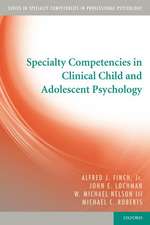Artificial Liver Support
Editat de G. Brunner, F. W. Schmidten Limba Engleză Paperback – 19 ian 2012
Preț: 721.96 lei
Preț vechi: 759.96 lei
-5% Nou
Puncte Express: 1083
Preț estimativ în valută:
138.17€ • 143.71$ • 114.06£
138.17€ • 143.71$ • 114.06£
Carte tipărită la comandă
Livrare economică 14-28 aprilie
Preluare comenzi: 021 569.72.76
Specificații
ISBN-13: 9783642966316
ISBN-10: 3642966314
Pagini: 360
Ilustrații: XXI, 332 p.
Dimensiuni: 170 x 244 x 19 mm
Greutate: 0.57 kg
Ediția:Softcover reprint of the original 1st ed. 1981
Editura: Springer Berlin, Heidelberg
Colecția Springer
Locul publicării:Berlin, Heidelberg, Germany
ISBN-10: 3642966314
Pagini: 360
Ilustrații: XXI, 332 p.
Dimensiuni: 170 x 244 x 19 mm
Greutate: 0.57 kg
Ediția:Softcover reprint of the original 1st ed. 1981
Editura: Springer Berlin, Heidelberg
Colecția Springer
Locul publicării:Berlin, Heidelberg, Germany
Public țintă
ResearchCuprins
I. General Aspects of Hepatic Failure.- Mechanism of Liver Cell Destruction in Fulminant Hepatic Failure.- Enzyme Patterns in Liver Failure.- Synergism Among Toxic Factors and Other Endogenous Abnormalities in Hepatic Encephalopathy.- On the Role of Free Phenols in the Blood of Patients in Hepatic Failure.- The Biochemistry of Hepatic Detoxification.- Determination of Liver Function and Liver Regeneration in Fulminant Hepatic Failure.- II. Hemoperfusion.- The Development of a Haemoperfusion Device for Chronic Use.- A New Charcoal Sorbent Fiber for Hemoperfusion.- Agarose-Encapsulated Adsorbents I. Concept and General Properties.- Agarose-Encapsulated Adsorbents II. Adsorption Characteristics.- Agarose-Encapsulated Adsorbents III. In Vitro Haemocompatibility.- Coating and Blood Compatibility of Amberlite XAD-4.- Development of a Blood-Compatible Resin for Artificial Liver Support.- Middle Molecules in the Serum of Patients and Rats with Liver Failure: Influence of Sorbent Haemoperfusion.- Bilirubin Removal by Sorbent Hemoperfusion from Jaundiced Blood.- Removal of Bile Acids by Various Means of Artificial Liver Support.- Charcoal Haemoperfusion with PGI2 in the Treatment of Fulminant Hepatic Failure.- Hormone Losses by Charcoal Hemoperfusion.- Hemoperfusion, Exchange Transfusion, Cross Circulation, Liver Perfusion, Hormones and Immobilized Enzymes.- Partial Hepatectomy and Subsequent Charcoal Hemoperfusion in the Conscious Rat.- III. Dialysis Procedures.- Large-Pore Hemodialysis in Fulminant Hepatic Failure.- Haemodialysis Procedures in Acute Liver Failure.- Correction of Increased Plasma Amino Acid Levels by Dialysis with Amino Acid-Electrolyte-Glucose Solutions.- Hemofiltration in Acute Liver Failure: Substitution with Electrolyte Solution Versus Normal Animal Ultrafiltrate.- Significance of Hepatic Energy Charge and Blood Ketone Body Ratio as Criteria of Liver Support. Indication and Efficiency in Hepatectomized Patients During Cross Dialysis.- IV. Amino Acid Level Concentration.- Effect of Liver Adapted Amino Acids on Portosystemic Encephalopathy in Patients with Cirrhosis of the Liver and Portosystemic Shunts.- Somatostatin: A New Therapeutic Agent for Treatment of Hepatic Encephalopathy?.- V. Plasmapheresis.- Continuous Flow Membrane Plasmapheresis Utilizing Cellulose Acetate Hollow Fiber in Hepatic Failure.- Augmented Solute Reduction in Diseases Treated by Extracorporeal Detoxification Systems: X-Effect Hypothesis.- Hemoperfusion-Induced Respiratory Distress Syndrome in an Animal Model: The Effects of Corticosteroids.- VI. Enzymatic Support.- Immobilized Hepatic Enzymes as a Tool in Extracorporeal Detoxification.- Immobilization of Ligandin on Hollow Fiber Reactors.- Detoxification of Phenols by Sulphate Conjugation: An Alternative to Glucuronidation in an Enzymatic Liver Support System.- Enzymatic Methylation of Mercaptans: Applicability in an Enzyme Reactor Liver Support System.- Liquid Membrane Enzyme Reactor for Artificial Liver Support.- Advances in the Development of Immobilized Enzymes for Future Extracorporeal Liver Support.- A Model Enzymic Extracorporeal Detoxification System —Part II.- VII. Isolated Liver Cells and Tissue.- Liver Assist by Cultured Cells on Artificial Capillaries.- Hemoperfusion over Small Liver Pieces for Liver Support.- Hepatocellular Transplantation into the Rat Spleen: Transplantation of Hepatocytes Isolated from Cirrhotic Liver.- VIII. Surgical Support.- Treatment of Acute Hepatic Failure by Extracorporeal Hemoperfusion over Human and Baboon Liver.- Experience in the Treatment of Hepatic Comaby Extracorporeal Liver Perfusion.- Functional Capacity of Extracorporeal Baboon Liver Perfusions.- Clearance of Bilirubin and Bile Acids from the Serum of Patients Treated by Extracorporeal Baboon Liver Perfusions.- The Influence of Baboon Liver Hemoperfusion on Serum Levels of Amino Acids and Free Fatty Acids in Patients with Acute Liver Failure.- Surface Redox Potential and Vitality of an Extracorporeal Liver During Hemoperfusion.- The Isolated Perfused Partially Hepatectomised Liver — A Source of Regeneration Stimulator Substance?.- Treatment of Acute Liver Failure by Extracorporeal Baboon Liver Perfusions — Viewed by a Patient.- Liver Regeneration Following Hepatic Resection Without Portal Blood.- Liver Transplantation and Impending Hepatic Failure.- Perspectives of Liver Transplantation in Cambridge.











